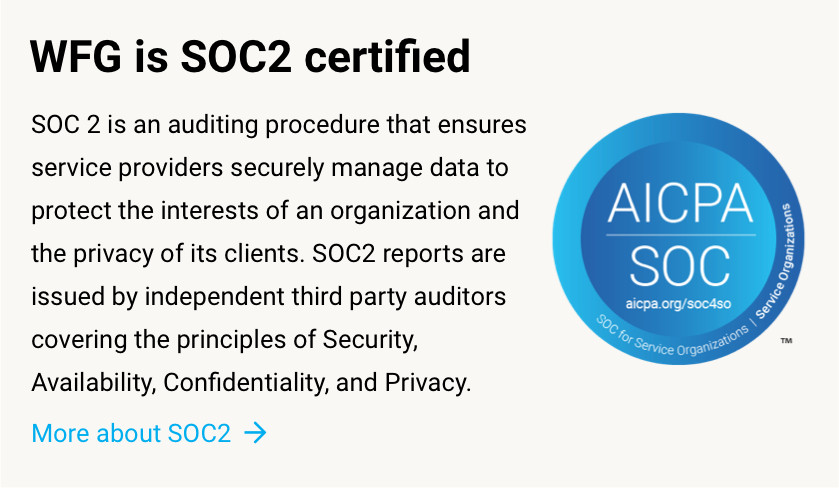No one thinks wire fraud can happen to them. In fact, more than half of homebuyers aren’t even aware of the risk of wire fraud. But wire fraud is real. That’s why WFG will always go the extra mile to keep your clients’ property transaction safe and secure. Here’s what you can expect from us:
- WFG will NEVER send you an email asking you to transfer money
- WFG delivers all wiring instructions through a secure portal
- WFG requires all changes to wire instruction be notarized
- WFG uses strong encryption to communicate sensitive information
- WFG monitors its network for cyber-attacks 24 hours a day
Wire fraud is the biggest threat to consumers because they can lose the most money in the shortest amount of time.”
Bruce A. Phillips, CISSP, SVP & Chief Information Security Officer
MyHome, a Williston Financial Group Company
AARON COLE Lost $125,000 to wire fraud | The Cole family thought they were closing on their dream house. Instead they walked into a wire fraud nightmare. Watch their cautionary tale and hear what happened next. Play Video
-
Over $17.1 Billion have been lost to wire fraud since 2014.
-
Wire fraud has increased by 4494% since 2014.
-
Since 2014 there have been 168,225 reports of wire fraud in the U.S.
-
Average real estate wire fraud lost in 2024 – $125,000.
Don’t trust free Wi-Fi. It can be easily impersonated. If that happens then the malicious attackers can capture everything you send or receive, including usernames and passwords. Here are some tips to keep your device safe while using free Wi-Fi:
- Never use public Wi-Fi networks to access sensitive information or business-related email. That means no checking your bank balance from Starbucks or reviewing closing documents at your airport gate. If you need to get online to browse for directions or do something else less sensitive, remember the risks you are taking
- Know the Wi-Fi network you’re connecting to. Don’t just blindly connect to any available network. If you’re in a restaurant, coffee shop, hotel, or other business, verify the name of their Wi-Fi network. Choose networks that require a password over open networks.
- Use a Virtual Private Network (VPN). This is a must if you regularly use public Wi-Fi or need to access sensitive information or business-related email. You can find a variety of trusted VPN services online, but if you want a trustworthy and reliable service you’ll have to pay for it.
- Only browse websites that start with HTTPS while on public Wi-Fi and avoid those that start with HTTP. Websites that start with HTTPS are encrypted, adding an extra layer of security and making your browsing more secure. If you connect to an unsecured Wi-Fi network and use regular HTTP instead of HTTPS, your traffic is visible if hackers are snooping around in the network. Never enter a password into a website that does not use HTTPS.
- Don’t automatically connect to available Wi-Fi hotspots. You can turn off that feature in your device’s wireless settings.
- Change your email password regularly and enable Second Factor Authentication on your email account. Change your password every 90 days to a strong 10-character password. If your email provider doesn’t support Second Factor Authentication, you should consider changing your email provider. Those two simple actions ensure that you’re no longer the source of information attackers use to defraud your clients.
- Don’t use the same password for everything. If you do, a malicious attacker only needs to find that one password to gain access to everything (email, banking, investments, etc.), and they’ll try that one password everywhere. Don’t use similar passwords. Changing a number or a couple of letters won’t keep malicious attackers from recognizing your password pattern and using it to find your other passwords quickly.
- Don’t trust links received in email. If you want to visit the web site, type the URL into your browser. Don’t trust files attached to an email, especially from unknown senders or if you’re not expecting a document. When in doubt, pick up the phone and call to confirm that the sender sent you a file.
- Use commercial anti-virus software. Update it frequently or set your account to auto-update.
- Patch or update your computer software as soon as updates are released.
- Update your phone’s software as soon as you can. Attacks on phones are increasing.
Wire fraud, hands down. The number of attempts has increased dramatically and the success rate of malicious attackers has also gone up. And, unfortunately the success rate in retrieving stolen funds has gone down.
There are a couple of reasons. First, the change in target from settlement services to buyers has resulted in better success rates for malicious attackers. That success has drawn additional malicious attackers into the game. And second, this new wave of malicious attackers means new techniques for perpetrating attacks.
Two-factor authentication.
Two-factor authentication (2FA) is a way to add additional security to your account. The first “factor” is your usual password that is standard for any account. The second “factor” is a verification code retrieved from an app on a mobile device or computer. 2FA is conceptually similar to a security token device that banks in some countries require for online banking. Other names for 2FA systems include OTP (one-time password) and TOTP (Time-based One-time Password algorithm).
WFG will NEVER send you an email asking you to transfer money.
